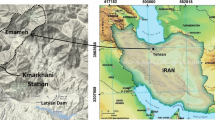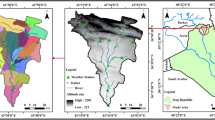Abstract
Erosion has been as a major issue in Bhagirathi and Alaknanda river basins due to high surface runoff. The river basins are located in the Uttarakhand state of India and have a total basin area of 19,066.5 km2. Sediment yield has been estimated and then correlated with the surface runoff using geospatial techniques during the period 2000–2015. Analytic hierarchy process (AHP) has been used to estimate the sediment yield. All required layers for assessment of runoff and sediment yield has been prepared in a geographical information system environment. Tropical Rain Measuring Mission (TRMM) rainfall data (0.25° × 0.25°), Global Land Data Assimilation System (GLDAS) runoff data (0.25° × 0.25°), Advanced Spaceborne Thermal Emission and Reflection Radiometer (ASTER) elevation data (30 m), and Landsat 5 and Landsat 8 satellite images (30 m) have been used to prepare rainfall maps, runoff maps, relief maps, and land use/land cover maps respectively. The study has shown that the sediment yield, as well as runoff, has a non-monotonic trend during 2000 to 2015. The highest runoff has been observed in the year 2013 whereas minimum runoff was in the year 2009. Correspondingly, the highest and lowest sediment yields were observed in the years 2013 and 2009 respectively. The northern part of the catchment was observed to be more vulnerable with respect to high sediment yield as well as runoff. As a whole, both river basins have a strong positive correlation between sediment yield and runoff with R2 values of 0.8. With respect to the findings, it can be concluded that some of the reservoirs for hydropower projects within these river basins may be in danger in the near future due to high sediment yields.










Similar content being viewed by others
References
Jasrotia AS, Dhiman SD, Aggarwal SP (2002) Rainfall-runoff and soil erosion modeling using remote sensing and GIS technique—a case study of tons watershed. J Indian Soc Remote Sens 30(3):167–180
AHEC (2011) Assessment of cumulative impact of hydropower projects in Alaknanda and Bhagirathi basins. Report published by IIT Roorkee. https://www.iitr.ac.in/departments/AH/pages/index.html
Choudhari K, Panigrahi B, Paul JC (2014) Simulation of rainfall-runoff process using HEC-HMS model for Balijore Nala watershed, Odisha, India. Int J Geomatics Geosci 5(2):2014
Gajbhiye S (2015) Estimation of surface runoff using remote sensing and geographical information system. Int J Sci Technol 8(4):113–122
Kabiri R, Chan A, Bai R (2013) Comparison of SCS and Green-Ampt methods in surface runoff-flooding simulation for Klang watershed in Malaysia. Open J Mod Hydrol 2013(3):102–114. https://doi.org/10.4236/ojmh.2013.33014
Milliman JD, Meade RH (1983) Worldwide delivery of river sediments to the oceans. J Geol 91:1–19
Peter G. Griffiths, Richard Hereford, and Robert H. Webb (2006) Sediment yield and runoff frequency of small drainage basins in the Mojave Desert, California and Nevada. U.S. Department of the Interior U.S. Geological Survey
Ramamoorthi AS, Haefner H (1991) Runoff modelling and forecasting of river basins, and Himalayan Snow cover Information System (HIMSIS), Hydrology for the Water Management of Large River Basins (Proceedings Of The Vienna Symposium, August 1991). Iahs Publ. No. 201, 199
Rawat JS, Rawat MS (1994) Accelerated erosion and denudation in the Nana Kosi watershed, Central Himalya, India. Part I: sediment load. J Mountain Res Develop 14(1):25–38
Saaty TL (1980) The analytic hierarchy process: planning, priority setting, resource allocation. New York: McGraw-Hill; p. 287
Mishra SK, Tyagi JV, Singh VP, Singh R (2005) SCS-CN-based modeling of sediment yield. J Hydrol 324(2006):301–322
Subramanian, V.: 1996, The sediment load of Indian rivers—an update, in D. E. Walling and B. W. Webb (eds), Proc. Erosion and Sediment Yield: Global and Regional Perspectives, IAHS Publication No. 236
Kothyari UC, Jain SK (1997) Sediment yield estimation using GIS. Hydrol Sci J 42(6):833–843. https://doi.org/10.1080/026266697094920
Valdiya KS (1985) Accelerated erosion and landslide-prone zones in the Central Himalaya, Concepts and Strategies, Gyanodaya Prakashan, Nainital, pp. 122–138
Xixi Lu, David L. Higgitt (1999) Sediment yield variability in the Upper Yangtze, China. Earth Surface Processes and Landforms Earth Surf. Process. Landforms 24, 1077±1093 (1999)
Author information
Authors and Affiliations
Corresponding author
Ethics declarations
Conflict of Interest
The authors declare that they have no conflict of interest.
Ethical Approval
This research article does not contain any studies with human participants or animals performed by any of the authors.
Informed Consent
Informed consent was obtained from all individual participants included in the study.
Rights and permissions
About this article
Cite this article
Kushwaha, A.P., Pandey, A.C. & Mahto, S.S. Assessment of Runoff Pattern and Relationship to Sediment Yield of Bhagirathi–Alaknanda River Basin Using Geospatial Techniques. J geovis spat anal 2, 9 (2018). https://doi.org/10.1007/s41651-018-0016-8
Published:
DOI: https://doi.org/10.1007/s41651-018-0016-8




